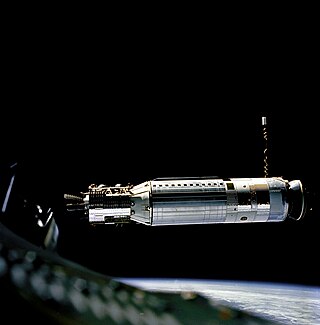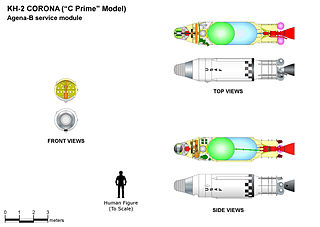
The RM-81 Agena was an American rocket upper stage and satellite bus which was developed by Lockheed Corporation initially for the canceled WS-117L reconnaissance satellite program. Following the division of WS-117L into SAMOS and Corona for image intelligence, and MIDAS for early warning, the Agena was later used as an upper stage, and an integrated component, for several programs, including Corona reconnaissance satellites and the Agena Target Vehicle used to demonstrate rendezvous and docking during Project Gemini. It was used as an upper stage on the Atlas, Thor, Thorad and Titan IIIB rockets, and considered for others including the Space Shuttle and Atlas V. A total of 365 Agena rockets were launched between February 28, 1959 and February 1987. Only 33 Agenas carried NASA payloads and the vast majority were for DoD programs.

BYEMAN codenamed LANYARD, the KH-6 was the unsuccessful first attempt to develop and deploy a very high-resolution optical reconnaissance satellite by the United States National Reconnaissance Office. Launches and launch attempts spanned the period from March to July 1963. The project was quickly put together to get imagery of a site near Leningrad suspected of having anti-ballistic missiles. The satellite carried Itek's "E-5" camera developed for the SAMOS program, which had been cancelled. The camera had a focal length of 1.67 m and could discern objects on the ground 1.8 m in size. The ground swath of the camera was 14 km × 74 km. The satellite weighed 1,500 kg (3,300 lb), and had a single re-entry vehicle in which exposed film was returned to earth for a mid-air aircraft recovery. The KH-6 was manufactured by Lockheed Martin and launched from Vandenberg Air Force Base on Thor-Agena D launch vehicles.
Thor was a US space launch vehicle derived from the PGM-17 Thor intermediate-range ballistic missile. The Thor rocket was the first member of the Delta rocket family of space launch vehicles. The last launch of a direct derivative of the Thor missile occurred in 2018 as the first stage of the final Delta II.
Discoverer 30, also known as Corona 9022, was an American optical reconnaissance satellite which was launched in 1961. It was a KH-3 Corona''' satellite, based on an Agena-B rocket.

The Thor-Delta, also known as Delta DM-19 or just Delta was an early American expendable launch system used for 12 orbital launches in the early 1960s. A derivative of the Thor-Able, it was a member of the Thor family of rockets, and the first member of the Delta family.

Discoverer 25, also known as Corona 9017, was an American optical reconnaissance satellite which was launched in 1961. It was the fifth of ten Corona KH-2 satellites, based on the Agena-B.
Discoverer 24, also known as Corona 9018A, was an American area survey optical reconnaissance satellite which was launched in 1961 but failed to achieve orbit. It was a KH-5 Argon satellite, based on an Agena-B. It was the third KH-5 to be launched.
FTV-1126, also known as Corona 9034A, was an American area survey optical reconnaissance satellite launched in 1962. It was a KH-5 Argon satellite, based on an Agena-B. It was also unofficially known as Discoverer 41, a continuation of the designation sequence used for previous US reconnaissance satellites, which had officially been discontinued after Discoverer 38. It was the first KH-5 satellite to complete its mission successfully.

Discoverer 22, also known as Corona 9015, was an American optical reconnaissance satellite which was lost in a launch failure in 1961. It was the fourth of ten Corona KH-2 satellites, based on the Agena-B.

Discoverer 26, also known as Corona 9019, was an American optical reconnaissance satellite which was launched in 1961. It was the sixth of ten Corona KH-2 satellites, based on the Agena-B.

Discoverer 28, also known as Corona 9021, was an American optical reconnaissance satellite which was lost in a launch failure in 1961. It was the seventh of ten Corona KH-2 satellites, based on the Agena-B.

Discoverer 16, also known as Corona 9011, was an American optical reconnaissance satellite which was lost in a launch failure on 26 October 1960. It was the first of ten Corona KH-2 satellites, based on the Agena-B.
Discoverer 29, also known as Corona 9023, was an American optical reconnaissance satellite which was launched in 1961. It was the first KH-3 Corona''' satellite, which was based on an Agena-B rocket.
Discoverer 31, also known as Corona 9024, was an American optical reconnaissance satellite which was launched in 1961. It was a KH-3 Corona''' satellite, based on an Agena-B.
Discoverer 32, also known as Corona 9025, was an American optical reconnaissance satellite which was launched in 1961. It was a KH-3 Corona''' satellite, based on an Agena-B.

Discoverer 33, also known as Corona 9026, was an American optical reconnaissance satellite which was lost in a launch failure in 1961. It was the eighth of ten Corona KH-2 satellites, based on the Agena-B.

Discoverer 35, also known as Corona 9028, was an American optical reconnaissance satellite which was launched in 1961. It was the last of ten Corona KH-2 satellites, based on the Agena-B.
Discoverer 36, also known as Corona 9029, was an American optical reconnaissance satellite which was launched in 1961. It was a KH-3 Corona satellite, based on an Agena-B rocket. It was the penultimate KH-3 satellite to be launched, the last successful mission, and the most successful of the program.
Discoverer 37, also known as Corona 9030, was an American optical reconnaissance satellite which was lost in a launch failure in 1962. It was the last KH-3 Corona‴ satellite, which was based on an Agena-B rocket.

Discoverer 10, also known as Corona 9007, was an American optical reconnaissance satellite launched on 19 Feb 1960 at 20:15:14 GMT, the seventh of ten operational flights of the Corona KH-1 spy satellite series.









